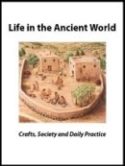Despite King David’s prominence in the Hebrew Bible, little archaeological evidence has been directly linked to the early years of the Kingdom of Judah. As a result, some scholars have argued that Judah only became a developed polity in the ninth or even eighth century B.C.E. A 2021 study, however, seeks to refute this idea based on the findings of an extensive regional archaeological project in the Judean foothills, the very region where the Bible says King David’s kingdom was born.
The study, published in the Jerusalem Journal of Archaeology by prominent Hebrew University archaeologist Yosef Garfinkel, examined the archaeological findings from four separate sites in the Judean foothills: Khirbet Qeiyafa, Khirbet el-Ra’i, Socoh, and Lachish. Far from showing a region devoid of population, the evidence revealed a small yet quickly expanding kingdom during the Iron Age IIA period (c. 1000–925 B.C.E.). Garfinkel suggests that this kingdom likely developed in Hebron before expanding north to include Jerusalem and Khirbet Qeiyafa (possibly biblical Sha‘araim) to the west. Soon thereafter, it grew further to include Lachish in the southwestern hill country, Beer Sheva in the Negev, and several other cities that would become large administrative centers in the latter centuries of the Iron Age (c. 925–586). This expansion closely mirrors the biblical description of King David’s kingdom beginning in Hebron and only later extending to Jerusalem, then growing further during the reign of King Solomon.

Through carbon-14 dating, the project was able to date the fortified city of Khirbet Qeiyafa and the smaller village of Khirbet el-Ra’i to the early tenth century. After Qeiyafa was destroyed, the nearby city of Beth-Shemesh became the region’s predominant stronghold. Then, in the late tenth century, during the reign of Rehoboam, Lachish was fortified as mentioned in 2 Chronicles 11:5–12. The recent Hebrew University excavations at Lachish unearthed a massive 10-foot-wide city wall on the site’s northern slope, which they dated using radiocarbon to the reign of Rehoboam. Based on these findings, Garfinkel suggests there are likely many other sites in the Judean foothills that date to the early years of the Kingdom of Judah.
According to Garfinkel, the earlier lack of archaeological evidence for this period can be attributed to not having data from excavated destruction layers. Destruction layers actually serve to preserve many archaeological finds that would otherwise have been removed or reused by a site’s inhabitants. As a result, periods of conflict often leave behind much clearer signs in the archaeological record. This can be seen especially towards the end of the Iron Age, where the destruction layers left behind by both the Assyrian and Babylonian armies are easily identified in many archaeological sites.
A version of this article originally appeared on BHD on October 15, 2021.
Read more in Bible History Daily:
Tel ‘Eton Excavations Reveal Possible Judahite Administrative Center
All-access members, read more in the BAS Library:
The ‘Daughters of Judah’ Are Really Rural Satellites of an Urban Center
Mizpah: Newly Discovered Stratum Reveals Judah’s Other Capital
Not a BAS Library or All-Access Member yet? Join today.The post King David’s Judah Found? appeared first on Biblical Archaeology Society.


0 Commentaires